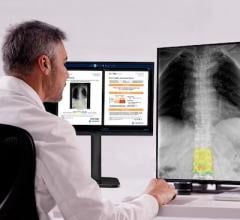
Annalise.ai, a global radiology artificial intelligence (AI) company, announced it has received U.S. Food and Drug Administration (FDA) 510(k) clearances covering an additional seven findings as part of the company’s AI-assisted triage and notification (CADt) solutions, including a suite of time-sensitive stroke findings and an expansion of findings for chest X-ray.
April 12, 2023 — A global radiology artificial intelligence (AI) company, Annalise.ai, has announced it has received U.S. Food and Drug Administration (FDA) 510(k) clearances covering an additional seven findings as part of the company’s AI-assisted triage and notification (CADt) solutions. The clearances, including a suite of time-sensitive stroke findings and an expansion of findings for chest X-ray, build on Annalise’s momentum and growth strategy in the U.S. market.
Annalise Triage uses deep learning to identify the suspected presence of time-sensitive pathologies and flag priority cases within the radiology worklist, assisting the care team in treating patients with the most critical conditions first, according to the company. AI solutions provide clinicians with a second set of eyes, allowing them to detect and protect with confidence and drive better health outcomes for all patients.
All FDA-cleared Annalise CXR and CT Brain findings are a subset of a comprehensive group of solutions, field-tested and available outside the U.S., with clinical studies showing improvements in detection accuracy, diagnostic decision-making, and reporting speed.
Annalise Triage CT Brain
The latest 510(k) cleared findings for use in triage and notification (CADt) for CT Brain are: Acute subdural/epidural hematoma; Acute subarachnoid hemorrhage; Intra-axial hemorrhage; Intraventricular hemorrhage.
“We are thrilled to mark our entry into the U.S. neuroimaging space with this set of high-precision tools for prioritizing intracranial hemorrhage cases on non-contrast head CT,” said Lakshmi Gudapakkam, CEO of Annalise.ai. He added, “Annalise.ai is committed to developing the highest quality tools for advancing patient care and patient care efficiency in the U.S.”
Annalise Triage Chest X-ray
Annalise.ai has also expanded its portfolio of FDA 510(k) cleared findings for CADt on CXR to a total of five, and now offers the highest number of findings for triage and notification on chest X-ray in the U.S. market. The findings now include the following: Pneumothorax; Tension pneumothorax; Pleural effusion; Pneumoperitoneum; and Vertebral compression fracture.
As with head CT, quickly identifying imaging findings via CXR can help expedite diagnosis, guide treatment decisions, and improve patient outcomes, noted the company statement detailing the clearance. These findings continue the company’s momentum in the U.S. — which received its first FDA clearance in February of 2022 and now includes a total of nine FDA cleared findings. The first CADt FDA clearance was for the triage and notification of pneumothorax on chest X-ray and was the first product available in the U.S. market to differentiate a tension pneumothorax, allowing a clinical site to apply specific triaging rules for the most urgent tension pneumothorax cases.
With accelerating advances in medical imaging technology, radiologists and other healthcare providers are now expected to diagnose patients quickly and accurately, noted the company-issued statement announcing FDA approval. It further specified its patient-first approach is clinician-led and comes from a deep understanding of the challenges faced in medical imaging.
Although medical imaging in the U.S. declined during the pandemic, there has been a rapid bounce back in imaging volumes to higher-than pre-pandemic levels (1) amidst a shrinking radiology workforce and increasing rates of physician burnout.
“AI-assisted triage is becoming increasingly important in healthcare,” said Rick Abramson, MD, MHCDS, FACR, Annalise.ai’s Chief Medical Officer. He added, “Triage solutions drive quality improvement by enabling earlier detection and intervention for our most critically ill patients. And by prioritizing the radiology worklist, these solutions also help address some of the burnout issues that have affected our specialty since the pandemic.”
According to the American Stroke Association, cerebral hemorrhage accounts for approximately 13 percent of all strokes in the United States, with an estimated 41,000 cases occurring each year. (2) Triaging specific subtypes of brain hemorrhage is important because each type has its own specific causes, symptoms, and treatments.
Annalise.ai is a joint venture between Australian healthcare technology company Harrison.ai and one of the world’s largest radiology companies, I–MED Radiology Network. The company is located in Australia, the United Kingdom, The Netherlands, and the United States. This product is not available for purchase by the general public.
For more information: https://usa.annalise.ai/
Find more HIMSS23 conference coverage here
References
(2) https://www.stroke.org/en/about-stroke/types-of-stroke/hemorrhagic-strokes-bleeds


 December 05, 2025
December 05, 2025 









